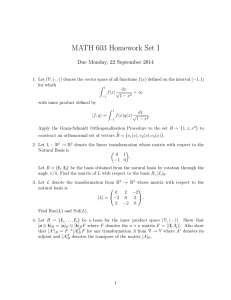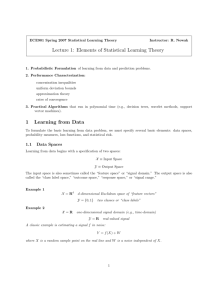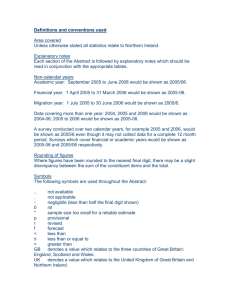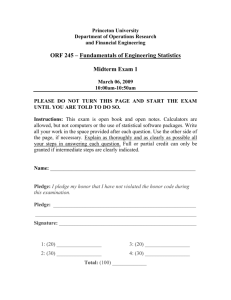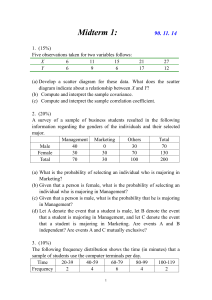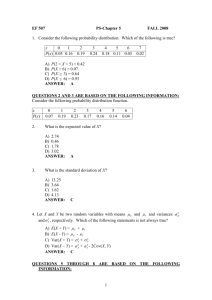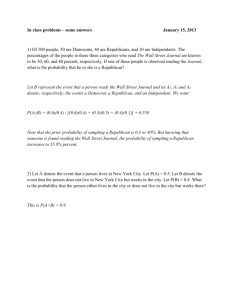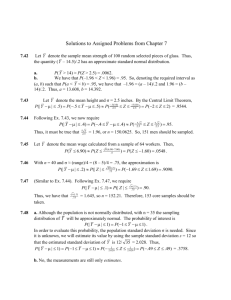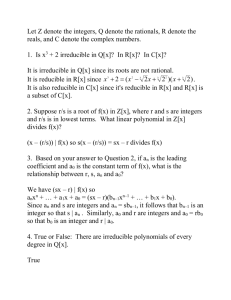STT 231
advertisement
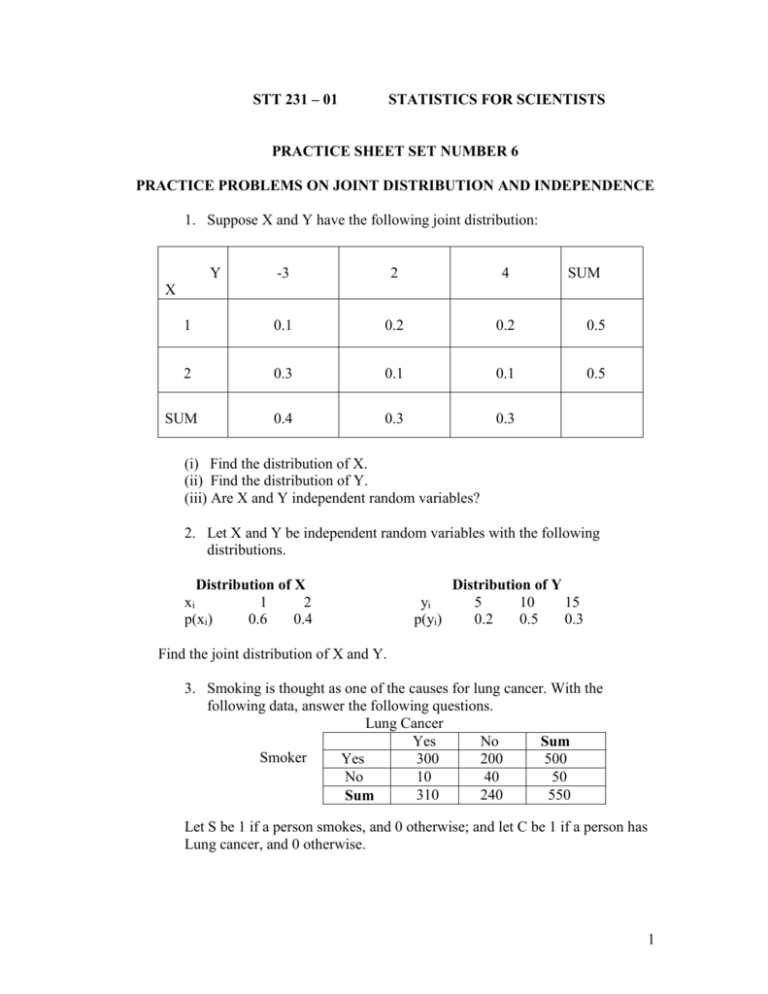
STT 231 – 01
STATISTICS FOR SCIENTISTS
PRACTICE SHEET SET NUMBER 6
PRACTICE PROBLEMS ON JOINT DISTRIBUTION AND INDEPENDENCE
1. Suppose X and Y have the following joint distribution:
Y
-3
2
4
SUM
1
0.1
0.2
0.2
0.5
2
0.3
0.1
0.1
0.5
0.4
0.3
0.3
X
SUM
(i) Find the distribution of X.
(ii) Find the distribution of Y.
(iii) Are X and Y independent random variables?
2. Let X and Y be independent random variables with the following
distributions.
Distribution of X
xi
1
2
p(xi)
0.6
0.4
yi
p(yi)
Distribution of Y
5
10
15
0.2
0.5
0.3
Find the joint distribution of X and Y.
3. Smoking is thought as one of the causes for lung cancer. With the
following data, answer the following questions.
Lung Cancer
Yes
No
Sum
Smoker
Yes
300
200
500
No
10
40
50
310
240
550
Sum
Let S be 1 if a person smokes, and 0 otherwise; and let C be 1 if a person has
Lung cancer, and 0 otherwise.
1
(a) Find the joint distribution of S and C. Give the distribution in the form of
a table.
C=1
C=0
S=1
S=0
(b) Compute the following probability:
P(S = 1) =
P(S = 0) =
P(C = 1) =
P(C = 0) =
(c) Is smoking independent of lung cancer? Verify you answer.
4. A fair coin is tossed three times. Let X denotes 0 or 1 according as a head
or a tail occurs on the first toss, and let Y denote the number of heads
which occur. Determine (i) the distributions of X and Y, (ii) the joint
distribution of X and Y.
5. Two cards are selected at random from a box which contains five cards
numbered 1, 1, 2, 2 and 3. Let X denotes the sum and Y the maximum of
the two numbers drawn. Determine the joint distribution of X and Y.
6. A fair coin is tossed four times. Let X denotes the number of heads
occurring and let Y denotes the longest string of heads occurring.
Determine the joint distribution of X and Y.
7. A service station has both self-service and full-service islands. On each
island there is a single regular unleaded pump with two hoses. Let X
denote the number of hoses being used on the self-service island at a
particular time, and let Y denote the number of hoses on the full-service
island in use at that time. The joint probability mass function (p.m.f.) of X
and Y appears in the accompanying tabulation.
2
y
x
P(x,y)
0
1
2
0
.10
.08
.06
1
.04
.20
.14
2
.02
.06
.30
(a) What is P(X = 1 and Y = 1)?
(b) Compute P(X 1 and Y 1).
(c) Give a word description of the event {X 0 and Y 0}, and
compute the probability of this event.
(d) Compute the marginal p.m.f. of X and of Y. Using Px(x), what is
P(X 1)?
(e) Are X and Y independent random variables? Explain.
8. When an automobile is stopped by a roving safety patrol, each tire is
checked for the tire wear and each headlight is checked to see whether it
is properly aimed. Let X denotes the number of headlights that need
adjustment and let Y denote the number of defective tires.
(a) If X and Y are independent with PX(0) = 0.5, PX(1) = 0.3, PX(2)
= 0.2, and PY(0) = 0.6, PY(1) = 0.1, PY(2) = PY(3) = 0.05, PY(4)
= 0.2, display the joint p.m.f. of (X,Y) in a joint probability
table.
(b) Compute P(X 1 and Y 1) from the joint probability table and
verify that it equals the product P(X 1).P(Y 1).
(c) What is P(X + Y = 0) [the probability of no violations]?
(d) Compute P(X + Y 1).
3
9. A certain market has both an express checkout line and a super-express
checkout line. Let X1 denote the number of customers in line at the
express checkout at a particular time of day, and let X2 denote the number
of customers in line at the super-express checkout at the same time.
Suppose the joint probability mass function of X1 and X2 is as given in
the accompanying table.
X1
P(X1,X2)
0
1
2
3
4
0
.08
.06
.05
.00
.00
1
.07
.15
.04
.03
.01
X2
2
.04
.05
.10
.04
.05
3
.00
.04
.06
.07
.06
(a) What is P(X1 = 1, X2 = 1), i.e., the probability that there is exactly
one customer in each line?
(b) What is P(X1 = X2), i.e., the probability that the numbers of
customers in the two lines are identical?
(c) Let A denote the event that there are at least two more customers
in one line than in the other line. Express A in terms of X1 and X2,
and calculate the probability of this event.
(d) What is the probability that the total number of customers in the
two lines is exactly 4? At least 4?
(e) Determine the marginal probability mass function of X1, and then
calculate the expected (mean) number of customers in line at
the express checkout.
(f) Determine the marginal p.m.f. of X2.
(g) By inspection of the probabilities P(X1 =4), P(X2 = 0), and
P(X1 = 4, X2 = 0), are X1 and X2 independent random variables?
Explain.
4
